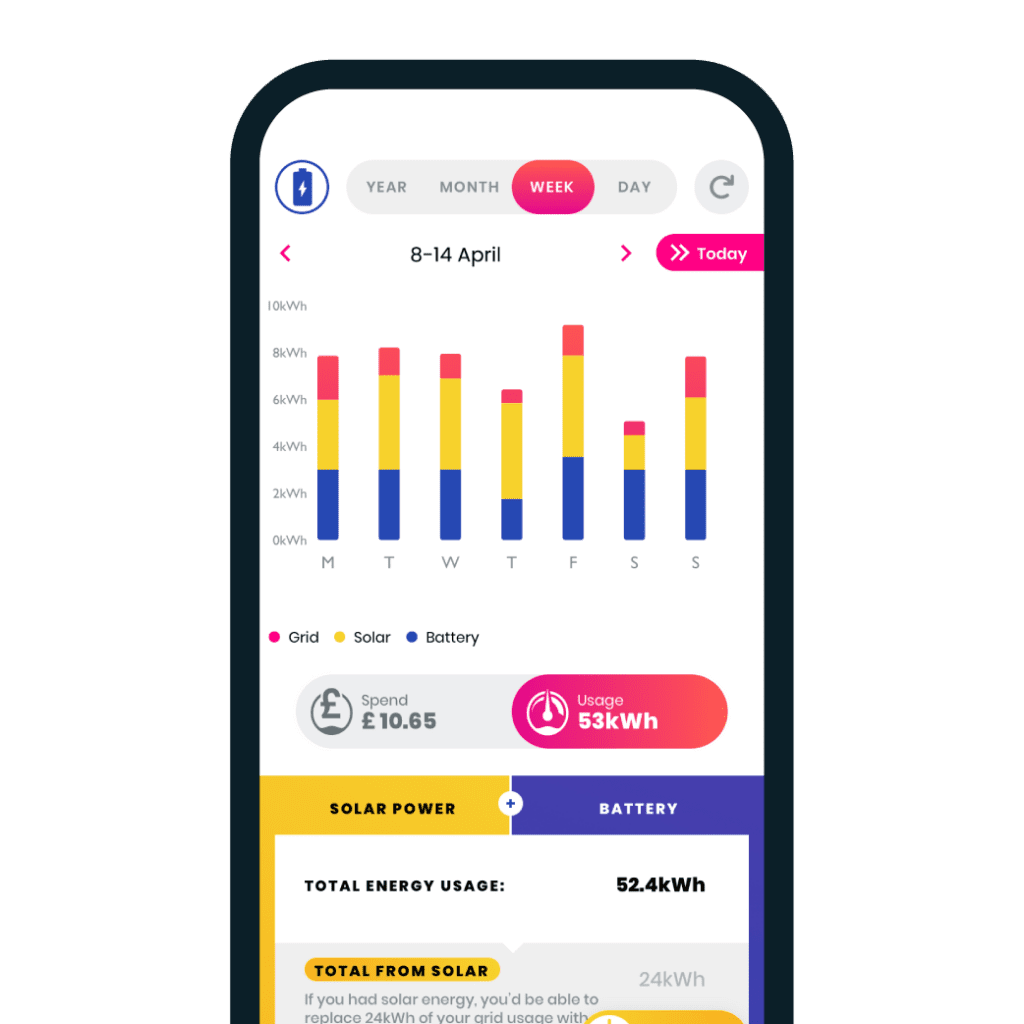Install a Home Battery with Loop
With battery costs at all-time lows and the government making batteries VAT free, there’s never been a better time to get a home battery. Use your solar energy when it’s dark, charge from cheap overnight power and watch your savings build up. Get a battery with Loop today.

Skip the queue for YOUR home battery!
If you’re looking for a home battery installer in your area, complete the form below and our partner installer will get in contact to arrange a survey.
We’re offering a fixed price installation for two of the most popular batteries in the UK:
4 kWh Smile G3 from AlphaESS for £3550
10.4 kWh Smile G3 from AlphaESS for £4700
The survey costs £120 which is taken off the above battery prices when you complete the installation.
Get your fast-track survey

Why should you install a home battery?
A home battery can lead to big cost savings. Here’s how:
Store excess solar energy during the day to use in the evening. This reduces how much electricity you buy from the grid, cutting your energy bills.
Switch to a tariff with a cheap overnight rate, store cheap overnight energy in your battery and use it during the day. Electric car or Economy 7 tariffs are perfect for this.
Sign up to flexibility schemes such as Loop’s Turn Down and Save scheme to be paid for helping to balance the grid.

Frequently asked questions
The Benefits
If you installed your panels before April 2019 then you're likely to be being paid for the energy you generate under the government’s feed-in-tariff. This pays you a fixed rate for each unit of energy generated. It also assumes that you export half the generated energy to the grid and pays you a fixed export rate for half of your generation.
How much you’d save by adding a battery will vary based on how much solar you currently generate and how much you use yourself. For homes without a battery, on average we see 70% of solar being exported to the grid. But this varies by house.
As a concrete example, take a home that currently generates 4000kWh per year, uses 1200 kWh and exports 2800 kWh. With an 11 kWh battery, the home could use an additional 1600 kWh of solar energy by storing it in the battery for use in the evenings. The home would buy 1600 kWh less electricity from the grid and save £464 at current price cap levels. Although the home exports less energy it isn’t penalised if its export payments are based on “deemed export”.
If the house is on a tariff with a cheap overnight rate such as Octopus’ Go tariff, they can also charge overnight at 9p/kWh. By shifting cheap overnight electricity into the day the home saves 19p/kWh compared to the price cap. Every 525 kWh shifted in this way saves the home an additional £100. If on average across the year the home shifts 4 kWh per day this way then the home would save an additional £300.
Finally, the house could be paid for exporting during flexibility schemes such as Loop’s Turn Down and Save scheme. This can add over £100/year to the savings.
By combining these three savings a home can expect to save between £500 and £900 per year.
If your solar array was installed after April 2019 you benefit from solar by needing to buy less energy from the grid, and get paid for exporting energy under the Smart Energy Guarantee. This uses your smart meter to measure how much you export and your supplier then pays you for this export. Each supplier can choose how much to pay.
For homes without a battery, on average we see 70% of solar being exported to the grid. How do these homes save money from a battery?
As a concrete example, take a home that currently generates 4000kWh per year, uses 1200 kWh and exports 2800 kWh. If the home were to use an additional 2000 kWh through the battery then they’d buy 2000 kWh less electricity from the grid and save £580 at current price cap levels. However, this comes at the cost of exporting 2000 kWh less energy to the grid. Depending on the Smart Export Guarantee tariff, this exported power can be worth between £80 and £600.
If the house is on a tariff with a cheap overnight rate such as Octopus’ Go tariff, they can also charge overnight at 9p/kWh. By shifting cheap overnight electricity into the day the home saves 19p/kWh compared to the price cap. Every 525 kWh shifted in this way saves the home an additional £100. If on average across the year the home shifts 4 kWh per day this way then the home would save an additional £300.
Finally, the house could be paid for exporting during flexibility schemes such as Loop’s Turn Down and Save scheme. This can add over £100/year to the savings.
By combining these three savings a home can expect to save between £300 and £900 per year. A lot of the variation comes from what export tariff the home is on.
A home that is paid a feed-in-tariff and has a smart meter can choose to move from deemed export to the Smart Export Guarantee. In the first example above, it would mean losing the deemed export of 2000 kWh paid at 6.79p (total payment £136) and replacing it with actual export of 800 kWh on a Smart Export Guarantee tariff. The best export payments are between 15p and 30p per kWh but some are as low as 4p/kWh. At the 20p level, the home would gain £24 overall by switching to actual export.
Given that you can’t switch back to deemed export, many homes will choose not to make this switch.
The Technicalities
As OFGEM explains on this page, feed-in-tariff customers must notify their FIT licensee when battery storage is connected to the accredited installation. For more information, see OFGEM’s Feed-in Tariffs: Guidance for renewable installations.
As OFGEM explains on this page, as long as your electricity generation (and export, if on metered export) can still be accurately measured, your payments will not be affected. However, if it can’t be, you can’t receive payments for that electricity.
You must be able to measure the electricity generated (and exported, if applicable) by the installation separately from all other sources to receive generation payments (and export payments, if metered).
For more in-depth guidance, together with example installation diagrams, please see OFGEM’s co-location of electricity storage guidance.
We've worked with our installation partners to ensure they can install these batteries at this price point in almost all homes.
There are two exceptions:
- Homes that do not have the physical space to host the battery safely. Installation will not be possible for these homes.
- Homes which would require an exceptional amount of cabling to safely install the battery. An additional cost to reflect this exceptional circumstance will be added.
But all other homes will pay the prices above.
Purchasing a Battery Without Solar
The benefits
- On a suitable tariff, cheap energy can be bought overnight, stored in the battery and then used during more expensive periods of the following day.
- Be paid for offering flexibility to the National Grid including through Loop’s Turn Down and Save scheme.
How much would I save?
The biggest savings we see are for households that have an Electric Vehicle and are on an EV tariff. EV tariffs have a cheap overnight period, charging your battery during this period to then use during the day can lead to large savings.
For example Octopus Go costs 9p/kWh between 12:30am and 4:30am. Batteries are 90% efficient, so to have 1 kWh of electricity to use at the middle of the day you need to buy 1.1 kWh of electricity overnight, costing 10p/kWh. Compared to the current price cap, this saves 19p/kWh. With an 11kWh battery the household could save up to £2.09/day or £763/year.
On top of this the house could be paid for exporting during flexibility schemes such as Loop’s Turn Down and Save scheme which can add up to over £100/year.
These savings rely on the household being on a cheap overnight tariff. Your supplier may insist you own an EV in order to access these cheap overnight rates and there’s no guarantee that they’ll be available for the full life of your battery.
Battery FAQs
Most home batteries have a lifespan of 10 to 15 years. This can vary depending on the type of battery, the depth of discharge, and how well it is maintained. Batteries come with a warranty against a certain length of time and/or number of times the battery goes through a charge/discharge cycle.
The 5.7 kWh Smile5 is just over 60 cm high, 60 cm wide, and 20 cm deep. The 11.4 kWh Smile 5 is two of the smaller batteries stacked together.
Home batteries can be installed indoors or outdoors, depending on the type of battery and your available space. Your installer will work with you to install the battery in the right spot for you.
The installation time for a home battery system will vary depending on the size and complexity of the system. However, you can typically expect the installation to take between one and two days.
Lithium-ion batteries require very little maintenance. The installation will be guaranteed by your installer for a year, and AlphaESS will guarantee that your battery will continue to perform for a minimum number of cycles that adds up to around ten years of typical use.
Once installed, it's recommended to:
- Visually inspect: Regularly check the battery for any signs of damage, leaks, or loose connections.
- Clean: Keep the area around the battery clean and free of dust and debris.
- Monitor performance: Use the battery's monitoring system or mobile app to track its performance and identify any potential issues.








